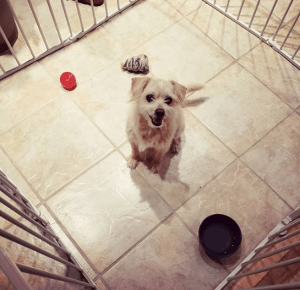Potty Training Your Puppy
Training your puppy to eliminate outdoors can be a very quick process, or can take weeks and even months. Each puppy develops and learns at their own pace. Be patient while they learn.
- Designate a potty area. Choose a location free of fun distractions such as sticks and other dogs. You will need a quiet, boring space to help your puppy relax enough to eliminate.
- At designated potty times (this will vary according to puppy), take your puppy ON LEASH to the potty location and wait 2 minutes. Be very boring during this time and resist the urge to play with your puppy or walk around with them. Stand still in the potty area.
- Result:
- If your puppy peed: tell them how good they are and either go for a walk or back inside where they can have freedom to run around and play for a while. Peeing earned the freedom in the house.
- If your puppy did not pee: Back in the house in their confinement area. Wait 5 minute to 30 minutes, depending on how excited or tired your puppy is and try again
If we set them up for success so they are eliminating outside, they are learning that peeing and pooping outside feels good.
When potty training, we set enough boundaries that no accidents (or very few) are occurring inside.

Tips
- Take your puppy out after eating, playing, drinking, and after anything exciting happen such as a visitor, a good play session, a plate is dropped on the floor.
- Keep records. How often is your puppy peeing? Pooping?
- If you think your puppy needs to poop, take them for a walk first or play a game to get them moving. Many puppies won’t poop until they have had some exercise. Keeping records will help with this piece.
Once you have a pattern of success, your puppy should want to go outside and will begin asking to go out. At first, this might look like a pause at the door, or jumping on you for attention.


Sample Schedule
2AM – Take puppy out for a pee and put them back in their area with a new chew.
6AM – Wake up, potty puppy. Short walk, some training, play time at home.
7AM – Puppy goes back into their containment area with a stuffed Kong for breakfast while you shower, have a coffee, etc.
8AM – Potty Puppy, free time in the house. Every 15 minutes, potty puppy.
10AM – Puppy Nap time with a Kong or chew
12PM – Potty Puppy, short walk & training time, play with toys at home.
Every 15 minutes, potty puppy.
2PM – Puppy Nap time with a Kong or chew
4PM – Potty Puppy, free time in the house. Every 15 minutes, potty puppy.
6PM – Puppy Nap time with a Kong or chew
8PM – Potty Puppy, short walk & training time, play with toys at home.
10PM – Puppy Bed Time.
Your puppy should sleep in an area where they won’t potty, or in a bathroom with a newspaper or pee pad if you are pee pad training. At first, set an alarm and take puppy out BEFORE they wake up crying. We don’t want them to learn that making a fuss gets us out of bet. I personally love to sleep in on occasion ![]()
